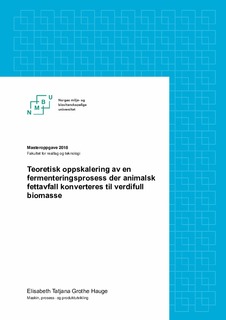| dc.contributor.advisor | Shapaval, Volha | |
| dc.contributor.author | Hauge, Elisabeth Tatjana Grothe | |
| dc.date.accessioned | 2018-11-13T13:31:42Z | |
| dc.date.available | 2018-11-13T13:31:42Z | |
| dc.date.issued | 2018 | |
| dc.identifier.uri | http://hdl.handle.net/11250/2572336 | |
| dc.description.abstract | This master thesis describes a process in which by-product from the slaughter industry is used as a raw material in a process where by-product animal fat is converted into a biomass with a high proportion of polyunsaturated fatty acids. This is done by fermentation with the microorganism Mortierella alpinawhich is an oleaginous fungus especially good at producing, among other fatty acids, arachidonic acid which is a high-value fatty acid. The fungus is fed with animal fat, thus converting and accumulating large quantities of intracellular fungal oil. In this task, the process will be scaled up from bench top scale to industrial scale. The process plant is dimensioned from a feedstock of 1000 kg of animal fat processed to a dried cell mass containing healthy oil. Yield from 1000 kg of animal fat is 190 kg of intracellular fungal oil. The task describes the components used in the plant, and mass calculations and energy calculations are used to further dimension the various components. A sonicator is used to make an emulsion of substrate mix and animal fat, and it is chosen to use a concentric airlift bioreactor as a fermentation tank. Furthermore, it is preferred to use a disc centrifuge to separate the remains of the substrate mixture and finally use a rotary dryer to dry the cell mass. The finished product in the processing plant is a dried pellet cell mass of 514.9 kg. | nb_NO |
| dc.description.abstract | I denne masteroppgaven beskrives en prosess hvor biprodukt fra slakteindustrien benyttes som råstoff i en prosess der biproduktet, animalsk fett, skal konverteres til en biomasse med høy andel av flerumettede fettsyrer. Dette gjøres ved hjelp av fermentering med mikroorganismen Mortierella alpina som er en oljeproduserende muggsopp spesielt god på å produsere blant annet arakidonsyre som er en ettertraktet fettsyre. Muggsoppen næres på animalsk fett, og kan dermed konvertere og akkumulere store mengder olje inne i cellen. I oppgaven skal denne prosessen oppskaleres fra laboratorieskala til industriskala. Prosessanlegget dimensjoneres utfra en råstoffmengde på 1000 kg animalsk fett som prosesseres til en tørket cellemasse inneholdende sunn olje. Utbytte fra 1000 kg animalsk fett er 190 kg intracellulær olje fra muggsopp. Oppgaven beskriver komponentene som benyttes i anlegget og det blir gjennomført masseberegninger og energiberegninger som brukes videre til å dimensjonere de ulike komponentene. Sonikator benyttes for å lage en emulsjon av substratblanding og animalsk fett, og det velges å bruke en airlift bioreaktor som fermenteringstank. Videre er det valgt å bruke en tallerken sentrifuge for å sentrifugere bort restene av substratblandingen og til slutt benyttes en roterende tørketrommel for å tørke cellemassen fra sentrifugeringen. Ferdigproduktet i prosessanlegget er en tørket cellemasse på 514,9 kg. | nb_NO |
| dc.language.iso | nob | nb_NO |
| dc.publisher | Norwegian University of Life Sciences, Ås | nb_NO |
| dc.rights | Attribution-NonCommercial-NoDerivatives 4.0 Internasjonal | * |
| dc.rights | Attribution-NonCommercial-NoDerivatives 4.0 Internasjonal | * |
| dc.rights.uri | http://creativecommons.org/licenses/by-nc-nd/4.0/deed.no | * |
| dc.title | Teoretisk oppskalering av en fermenteringsprosess der animalsk fettavfall konverteres til verdifull biomasse | nb_NO |
| dc.type | Master thesis | nb_NO |
| dc.subject.nsi | VDP::Teknologi: 500 | nb_NO |
| dc.description.localcode | M-MPP | nb_NO |

